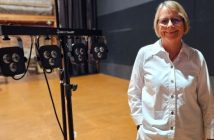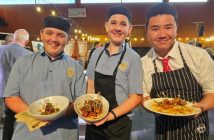Panel members, from left, Dallas Fisher, Russell Alexander, Dacey Balle and Wayne McNee.
Land opportunity, lower traffic congestion, and being on the doorstep of Auckland’s International Airport are huge advantages for Waikato, according to a panel discussion hosted by Deloitte and Waikato economic development agency Te Waka.
The panel discussion was part of the Shaping our slice of heaven: Regions of opportunity event, and focused on a report of the same name launched by Deloitte in May.
Business leaders from around Waikato gathered to discuss how the report findings could benefit the region’s economy, and where the growth potential lies.
On the panel were business people from different sectors: Te Waka chair Dallas Fisher, LIC chief executive Wayne McNee, Hobbiton Movie Set chief exexutive Russell Alexander and Balle Bros managing director Dacey Balle.
Liza Van der Merwe, associate director of Deloitte Access Economics, and Blair Keenan, principal economist for Waikato Regional Council, were keynote speakers.
Van der Merwe, who also co-authored the Shaping our slice of heaven: Regions of opportunity report, says Waikato has strong export potential in tourism, agriculture and food processing – areas the region should capitalise on.
“Waikato is in a good position to realise the opportunities that are presented, particularly in regards to tourism which was noted in our report to have the highest earning potential,” she says.
“Agribusiness is another key industry for Waikato, and has benefits for neighbouring regions in the form of domestic trade.”
Although agribusiness was discussed as a key export for the region, Van der Merwe says it also comes with its challenges, especially around sustainable practice.
“Agribusiness has a comparative advantage in New Zealand so the question is, how can farmers and those within the industry operate in a way that’s both sustainable and beneficial for the economy in the long-term?”
Van der Merwe said the report findings should be used as a tool for regions to work together to maximise economic success, rather than working in silos.
“We see the possibilities and prosperities that lie ahead for New Zealand if regions collaborate, and complement each other’s strengths and weaknesses. Businesses like Te Waka have already been capitalising on those opportunities.”
Fisher saw a challenge around the next level of quality accommodation for the region. “But the real challenge is building something that makes those hotels worth it,” he said. “We need tourism operators, we need events infrastructure. We need those things to be built to improve guest nights across seven days a week to make those hotels economic. It is a big challenge for us across the whole region.”
Alexander saw the region well positioned for tourism growth, particularly boosted by proximity to Auckland airport but without Auckland’s traffic congestion, and like Fisher saw a need for more accommodation.
Balle also saw the pressure on resources in the Auckland region creating opportunities in Waikato, and said policy settings needed to be right to attract the growth. “It’s not so much grabbing it from the neighbours, it’s just capturing it before it goes past.”
He said access to the Port of Tauranga was “fantastic” for Balle Bros’ setup.
McNee described the dairy industry as a game of two halves, with solid milk prices on the one hand but challenges and uncertainty around environmental issues including water quality and methane taxes.
“These challenges are also opportunities for us. We’ve reached what we call peak cow so we don’t think there will be any more cows in New Zealand than we had about three years ago. If you’re going to have less cows then you want to have better cows and that’s what we’re about.”
He said LIC had a variety of offerings for farmers and had just joined the Sustainable Business Council.
He also said LIC has 120 people in its tech team including data and research scientist and pointed to difficulties recruiting tech staff in Waikato. “We’ve got a great team of people but recruiting good people is a challenge for us.”
As an Aucklander driving down to the Hamilton base, he looked forward to the day the expressway is finished.
“Also, accommodation in Hamilton is a challenge. We bring a lot of people in and finding places for them to live here is a challenge for us.”
Fisher said now was the time to get Waikato working together on economic development. “I think everyone realises now is the time. we have to do it and if we don’t do it we will just be left behind in the race for resources.”
Michael Bassett-Foss, CEO of Te Waka, says they have been working with local iwi, council and businesses on boosting the region’s economy, as well as with nearby regions on maximising economic opportunities. He is confident they can also capture spillover from other regions, and support potential growth from both a regional and national perspective.
The Shaping our slice of heaven: Regions of opportunity report looks at the export potential of tourism, agribusiness, food processing and advanced manufacturing across five of New Zealand’s most populated regions.
According to the report, Waikato has the potential to earn $1.4 billion through tourism, and $500 million through agribusiness by 2040, if government export targets are met.
A further $800 million could be added to the local economy through food processing, which could also increase employment by 2900 FTE by 2040, according to the report.
See earlier story: https://wbn.co.nz/2019/05/31/tourism-sets-pace-for-future-regional-growth/





